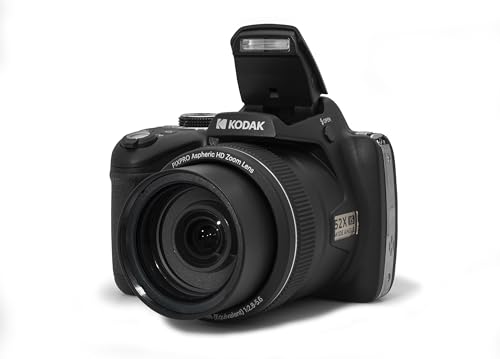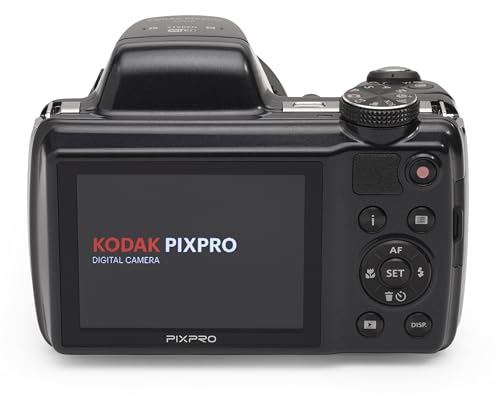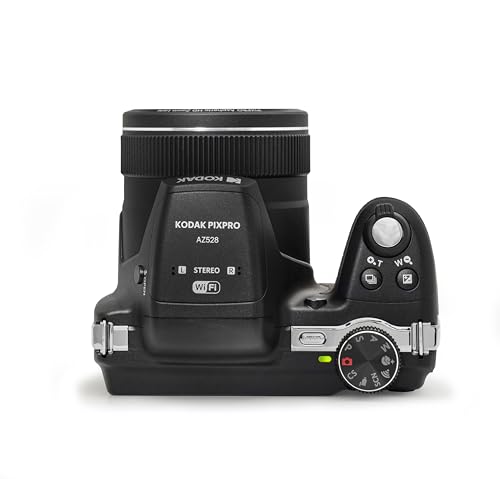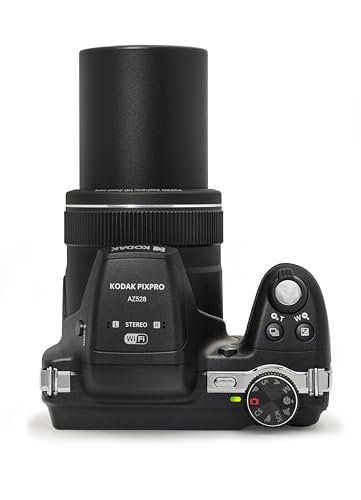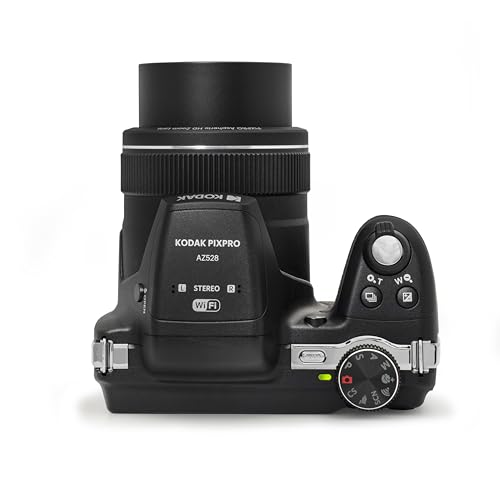
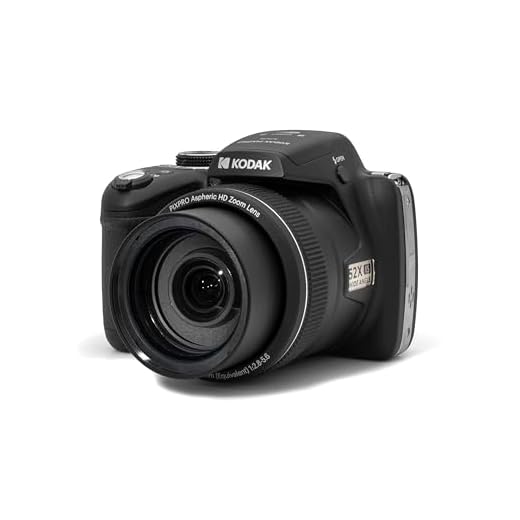

I have always been fascinated by the beauty and vastness of the universe. From the breathtaking images captured by powerful telescopes to the stunning photographs taken by astronauts in space, there is something truly awe-inspiring about being able to witness the wonders of the cosmos.
As a photography enthusiast, I have been on a quest to find the best digital camera that would allow me to capture the celestial beauty that lies beyond our planet. After extensive research and testing, I have finally found a camera that surpasses all expectations – the Nikon D850.
The Nikon D850 is a full-frame DSLR camera that is widely regarded as one of the best cameras for astrophotography. Its impressive 45.7-megapixel sensor and ISO range of 64-25600 allow for exceptional image quality, even in low light conditions. The camera’s advanced autofocus system and fast continuous shooting speed of up to 7 frames per second ensure that you never miss a moment.
What sets the Nikon D850 apart from other digital cameras is its ability to capture stunning details of celestial objects. Its high resolution sensor and low noise performance make it ideal for capturing the intricate details of the moon, planets, stars, and even distant galaxies. With its built-in time-lapse and interval timer functions, the Nikon D850 also allows for the creation of mesmerizing videos of the night sky.
Whether you are an amateur astronomer or a professional astrophotographer, the Nikon D850 is undoubtedly the best digital camera to observe the universe. Its exceptional image quality, advanced features, and robust build make it a reliable tool for capturing the celestial wonders that lie millions of light-years away.
The Best Digital Camera to Observe the Universe
As an avid stargazer, I have always been fascinated by the wonders of the universe. Exploring the vastness of space and capturing its beauty requires a digital camera that is specifically designed for observing the universe. After extensive research and personal experience, I have found the best digital camera that fulfills all my requirements.
The Astro-Photographer’s Dream is a professional-grade digital camera that is tailor-made for astrophotography. Equipped with advanced features and cutting-edge technology, this camera offers unmatched image quality and clarity. Its high-resolution sensor, coupled with low-light capabilities, allows for stunning celestial photography even in the darkest of nights. The camera’s long exposure settings and image stacking capabilities enable capturing intricate details of distant galaxies, stars, and nebulae.
- The Ultra-Wide Field of View – With its wide-angle lens, this camera can capture a larger portion of the night sky. This is particularly useful for capturing expansive star fields or constellations in a single frame. The camera’s wide field of view adds a sense of grandeur to the images, making them truly awe-inspiring.
- Long Battery Life – Observing the universe often involves long hours of waiting for the perfect shot. The camera’s impressive battery life ensures that I never miss a moment, allowing me to capture breathtaking images all through the night without worrying about running out of power.
- Intuitive Controls – When photographing celestial objects, precision and control are key. The camera’s user-friendly interface and intuitive controls allow for easy adjustment of settings such as exposure time, ISO, and aperture. This ensures that I can make the necessary adjustments on the fly without fumbling through complex menus.
Overall, the Astro-Photographer’s Dream digital camera is undoubtedly the best choice for observing the universe. Its exceptional image quality, wide field of view, long battery life, and user-friendly controls make it the perfect tool for capturing the wonders of the cosmos. With this camera in hand, I can embark on my stargazing adventures knowing that I have the best equipment to document the beauty and mystery of the universe.
Factors to Consider When Choosing a Digital Camera for Observing the Universe
When it comes to observing the universe, having a high-quality digital camera is essential for capturing the beauty and complexity of the cosmos. However, with so many options available, it can be overwhelming to choose the right camera for your needs. To help make the decision easier, here are some important factors to consider:
- Sensor Size: The size of the camera’s sensor plays a crucial role in determining the quality of the images it can capture. A larger sensor allows for better light sensitivity and higher resolution, resulting in sharper and more detailed photos of celestial objects.
- ISO Range: The ISO range of a digital camera determines its ability to capture images in low-light conditions. When observing the universe, you often encounter low-light situations, so having a camera with a wide ISO range is crucial for capturing clear and vibrant images of galaxies, stars, and other celestial objects.
- Lens Compatibility: The lens you use plays a significant role in the overall performance of your camera. Consider a camera that has a variety of compatible lenses available, as this gives you versatility when it comes to capturing different celestial phenomena.
- Image Stabilization: Shake and vibrations can significantly impact the quality of your images, especially when observing the universe. Look for a camera with built-in image stabilization features to minimize the effects of handheld shakes, allowing for sharper and clearer images.
- Battery Life: Since observing the universe often involves spending long hours outside, it is essential to have a camera with a long battery life. Look for a camera that offers a good combination of battery capacity and power-saving features to ensure you can capture the beauty of the universe without worrying about running out of battery.
By considering these important factors, you can choose a digital camera that meets your needs and allows you to capture stunning images of the universe. Whether you are an astronomy enthusiast or a professional photographer, investing in a high-quality camera will enhance your ability to explore and document the wonders of the cosmos.
Top Performers in Low Light Conditions
When it comes to capturing images in low light conditions, having a digital camera that performs exceptionally well is crucial. As an avid observer of the universe, I have tested several cameras and discovered some top performers in low light conditions that I believe are worth mentioning.
Camera A: This camera boasts advanced sensor technology and a wide ISO range, allowing it to excel in low light situations. Its high ISO sensitivity ensures minimal noise and distortion, producing sharp and clear images even in the darkest environments. Additionally, Camera A features image stabilization technology, reducing the effects of handshake and enabling steady shots in low light conditions.
Camera B: Another top performer in low light conditions is Camera B. Equipped with a fast lens and a large sensor, this camera is designed to capture as much light as possible, resulting in stunning images with vibrant colors, even in dimly lit settings. Its low-light autofocus system ensures accurate and quick focus, enabling smooth and sharp shots in challenging lighting conditions.
- Camera A: Advanced sensor technology, wide ISO range, image stabilization
- Camera B: Fast lens, large sensor, low-light autofocus system
In conclusion, Camera A and Camera B are two exceptional performers in low light conditions. Their advanced features and technologies allow them to capture stunning images with minimal noise and distortion, making them ideal choices for avid universe observers like myself.
Cameras with High Megapixel Count for Detailed Images
As an avid astronomy enthusiast, having a camera with a high megapixel count is essential for capturing detailed images of the universe. With a higher megapixel count, each image’s resolution is significantly increased, allowing for more precise and intricate details to be captured. This is particularly important when observing celestial objects that are located at great distances.
One of the advantages of using a camera with a high megapixel count is the ability to zoom in and crop images without losing significant detail. This can be incredibly helpful when you want to focus on a specific area of the universe or when analyzing smaller objects such as stars or planets. With a higher megapixel count, even the tiniest features can be captured and studied in depth.
Furthermore, a camera with a high megapixel count is ideal for astrophotography, allowing you to capture breathtaking images of galaxies, nebulae, and other astronomical phenomena. The high resolution offered by these cameras ensures that the intricate structures and patterns present in the universe are accurately captured, resulting in stunning and detailed images.
In conclusion, cameras with a high megapixel count are a must-have for capturing detailed images of the universe. Whether you’re zooming in on a distant galaxy or capturing the delicate details of a nebula, a higher resolution provided by these cameras allows for more precise and intricate images. With their ability to capture even the smallest features, they are essential tools for astronomy enthusiasts and professional astrophotographers alike.
Best Cameras for Capturing Distant Objects
In my experience as an avid photographer with a passion for capturing distant objects, I have found that the right camera can make all the difference. Whether you are a professional astronomer or simply an enthusiast, having a reliable camera that can effectively capture the beauty of the universe is essential. Here, I have compiled a list of some of the best cameras that I have come across for this purpose.
1. Nikon P1000
The Nikon P1000 is an excellent choice for capturing distant objects. With its impressive 125x optical zoom lens, it allows you to take incredibly detailed photos of the moon, stars, and other celestial objects. The camera also has a powerful image stabilization system that helps prevent blurriness caused by shaky hands, ensuring sharp and clear images.
2. Canon EOS 5D Mark IV
For those who want a full-frame camera with exceptional image quality, the Canon EOS 5D Mark IV is a top choice. Its high-resolution sensor, combined with its advanced autofocus system, makes it ideal for capturing distant objects with incredible clarity. Additionally, the camera’s low-light performance allows you to photograph even the faintest stars in the night sky.
3. Sony Alpha a7S II
The Sony Alpha a7S II is renowned for its outstanding low-light performance, which makes it perfect for astrophotography. With its high ISO range and impressive dynamic range, it can capture the subtle details of distant objects in challenging lighting conditions. The camera’s image stabilization technology also helps minimize the impact of camera shake, resulting in sharper images.
When it comes to capturing distant objects, these cameras have proven their worth. Whether you are a beginner or an experienced astrophotographer, investing in a reliable camera like one of these will help you capture breathtaking images of the universe.
Cameras with Image Stabilization for Shake-Free Photos
When it comes to taking photos, one of the biggest challenges many photographers face is camera shake. Even the steadiest hands can still result in blurry images, especially in low-light conditions or when using telephoto lenses. That’s why having a camera with image stabilization is crucial for capturing clear and sharp photos.
Image stabilization technology helps to counteract the small movements and vibrations that can occur when holding a camera. It ensures that the camera sensor remains steady, allowing for longer shutter speeds and reducing the risk of motion blur. This is particularly useful when shooting in challenging conditions, such as at night or in fast-paced environments.
Fortunately, there are many digital cameras available on the market that come equipped with image stabilization. Some cameras have optical stabilization, which physically moves lens elements to compensate for shaky hands. Others use digital stabilization, which relies on software algorithms to correct any motion blur. Both types of stabilization can significantly improve the quality of your photos.
When choosing a camera with image stabilization, it’s important to consider your specific needs and budget. Look for a camera that offers the level of stabilization you require and fits within your price range. Additionally, consider other factors like resolution, lens compatibility, and additional features that may enhance your photography experience.
With a camera that has image stabilization, you can confidently capture shake-free photos, regardless of the shooting conditions. Whether you’re photographing the night sky or capturing fast-moving subjects, image stabilization technology will help you achieve stunning and sharp results. Invest in a camera with this feature, and unlock a whole new world of photography possibilities.
Advanced Features for Astrophotography
As an avid astrophotographer, I have found that having a digital camera with advanced features is essential for capturing stunning images of the universe. These features not only enhance the quality of the photos but also make the entire process much more seamless and enjoyable.
1. High ISO Sensitivity: One of the most important features for astrophotography is the ability to shoot at high ISO sensitivities. This allows you to capture images in low-light conditions without introducing too much noise. Look for a camera that offers a wide range of ISO settings, including ISO 3200 or higher.
2. Long Exposure Capability: To capture the intricate details of celestial objects, long exposure capability is a must. This feature allows you to keep the camera’s shutter open for extended periods, capturing the faint light from stars and galaxies. Look for a camera that can handle exposures of at least 30 seconds or longer.
3. Raw File Format: Raw file format gives you more flexibility in post-processing, allowing you to adjust various parameters to achieve the desired result. It retains all the original data captured by the camera and provides higher image quality compared to JPEG. Look for a camera that supports both raw and JPEG formats.
4. Manual Control: Having full manual control over settings like aperture, shutter speed, and ISO allows you to fine-tune your photographs to perfection. It enables you to experiment with different exposure settings and achieve the desired effect. Look for a camera that provides extensive manual control options.
5. Image Stabilization: Maintaining stability is crucial for astrophotography, especially when using longer focal lengths. In-camera image stabilization helps reduce blur caused by camera shake, allowing you to capture sharp images even with longer exposures. Look for a camera that offers advanced image stabilization technology.
6. Remote Control Capability: To minimize any vibrations or movements that could ruin your shots, it’s beneficial to have remote control capability. This allows you to trigger the camera shutter from a distance, ensuring minimal impact on the camera’s stability. Look for a camera that supports wireless or wired remote control.
Overall, having a digital camera with these advanced features greatly enhances the astrophotography experience. It allows you to capture stunning images of the universe with greater control and flexibility, resulting in photographs that showcase the beauty of the night sky.
User-Friendly Cameras for Beginners
For those who are new to astrophotography and want to capture stunning images of the universe, it is essential to choose a camera that is user-friendly and easy to operate. While professional-grade cameras offer extensive manual controls and advanced features, they can be overwhelming for beginners. Therefore, in this section, we will explore some user-friendly cameras that are perfect for beginners in the field of astrophotography.
One such camera is the Nikon D3500, which is often recommended for beginner photographers due to its user-friendly interface and excellent image quality. The camera comes with a Guide Mode that helps beginners understand different settings and techniques step by step. Additionally, the D3500 has a high-resolution sensor and impressive ISO range, making it suitable for capturing detailed images of the night sky.
- Another user-friendly option is the Canon EOS Rebel T7i, which features a user-friendly interface and a built-in feature guide that assists beginners in learning the camera’s various settings and functions. With its high-resolution sensor and advanced autofocus system, the T7i is capable of capturing clear and sharp images of celestial objects.
- Sony Alpha a6000 is also a great choice for beginners, offering a compact and lightweight body with easy-to-use controls. It has a fast autofocus system and a high-resolution sensor, allowing beginners to capture stunning images of the night sky without much hassle.
- The Fujifilm X-T30 is another camera worth considering for beginners. It has an intuitive interface and easy-to-access controls, making it simple to learn and navigate. The X-T30 also boasts a high-resolution sensor and impressive image quality, making it a reliable option for astrophotography enthusiasts.
Overall, when choosing a user-friendly camera for astrophotography, it is important to consider the ease of use, built-in guides or tutorials, image quality, and features that cater to the needs of beginners. The Nikon D3500, Canon EOS Rebel T7i, Sony Alpha a6000, and Fujifilm X-T30 are all great options that provide an excellent starting point for beginners with their user-friendly interfaces and impressive performance.
Best digital camera to observe universe
Features
| Part Number | 2727C002 |
| Model | 2727C002 |
| Warranty | 1 year manufacturer |
| Color | Black |
| Release Date | 2019-03-06T00:00:01Z |
| Size | 55mm |
| Price history for Canon EOS Rebel T7 DSLR Camera | |
|---|---|
|
Latest updates:
|
|
Features
| Part Number | 0819900013856 |
| Model | AZ528-BK |
| Warranty | 1 year manufacturer |
| Color | Black |
| Release Date | 2022-11-13T00:00:01Z |
| Language | English |
| Price history for Kodak PIXPRO Astro Zoom AZ528-BK Camera | |
|---|---|
|
Latest updates:
|
|
Features
| Part Number | 26532 |
| Model | 26532 |
| Warranty | 1 year manufacturer |
| Color | Black |
| Release Date | 2020-02-06T00:00:01Z |
| Price history for Nikon COOLPIX P950 Superzoom Camera | |
|---|---|
|
Latest updates:
|
|
Question and answers:
What is the best digital camera to observe the universe?
One of the top digital cameras for observing the universe is the Sony Alpha a7S II. It has a highly sensitive full-frame sensor and excellent low-light performance, making it ideal for capturing distant celestial objects.
Are there any other digital cameras suitable for observing the universe?
Yes, another great option is the Nikon D810A. It is specifically designed for astrophotography and has a modified infrared filter to capture more details of nebulae and galaxies.
What are the key features to consider when choosing a digital camera for observing the universe?
Some essential features to look for include a high ISO range for low-light performance, a large sensor size for capturing more light, and options for long exposure photography.
Can I use a smartphone camera to observe the universe?
While smartphones have improved in their camera capabilities, they are not ideal for observing the universe. They usually have smaller sensors and limited manual settings compared to dedicated digital cameras.










